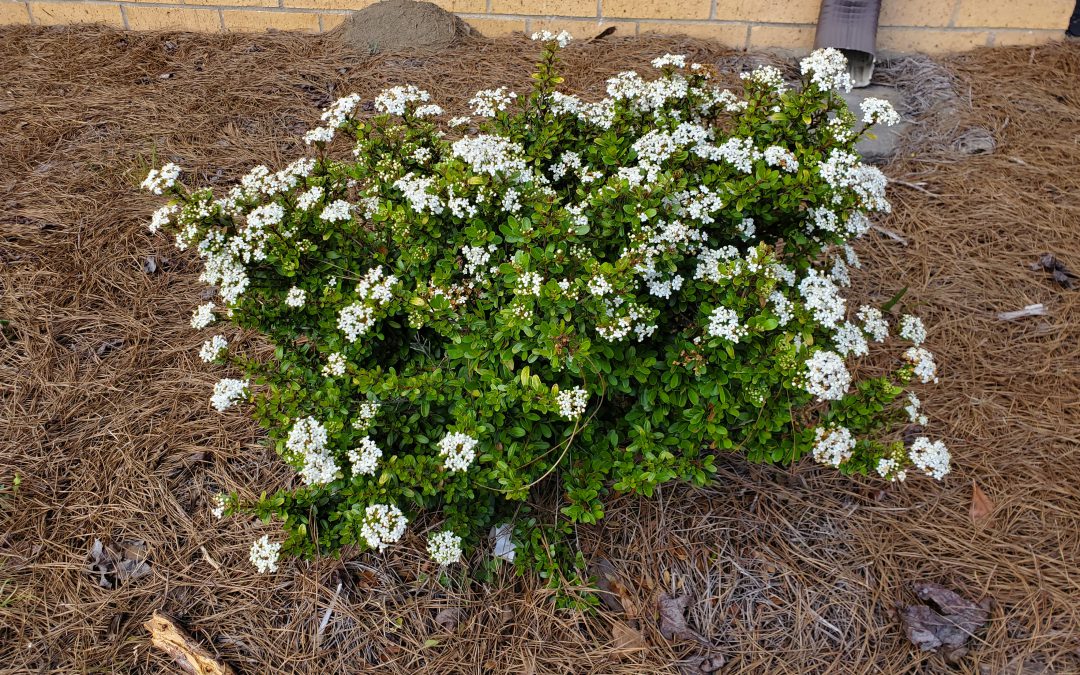
by Daniel J. Leonard | Apr 14, 2022
Lost in the sea of more popular and showy spring-flowering landscape shrubs like azalea, spirea, and the like, is an underused, exceedingly tough, and currently flowering Florida native shrub that is deserving of a spot in your landscape, Walter’s Viburnum (Viburnum obovatum).
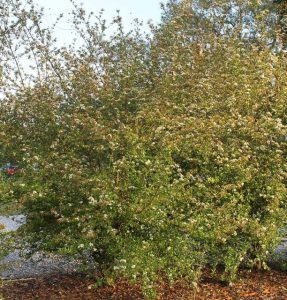
Species Walter’s Viburnum (Viburnum obovatum). Photo Credit: UF/IFAS.
Walter’s Viburnum, named for English-born botanist turned South Carolina farmer Thomas Walter, who first described the species in the late 1700’s, is a spring-flowering mostly evergreen shrub/small tree native to the Southeastern United States. In its native environment around hammocks, swamp edges, and near-river forests beneath the understory of canopy trees, Walter’s specimens often grow to around 15’ in height, live for more than 50 years, and spread slowly into loose thickets from their extensive underground root system. After covering themselves in clusters of small, showy, pollinator-attracting white flowers in spring, Walter’s produces small reddish-black fruit that are magnets for birds and other small wildlife in summer.
Though this tough, low-maintenance nature and gorgeous pure white March flower display should have seemingly enabled Walter’s to be a standout in the landscape, Walter’s Viburnum languished in popularity for many years as it didn’t fit into most landscapes in its wild form. Not too many folks in modern landscape situations are looking for a thicket forming, unkempt-looking tree! However, with increased breeding efforts aimed at selecting superior dwarf varieties and the rise in interest in using low-maintenance native plants, Walter’s has rapidly gained market share on traditional flowering shrubs in nurseries and yards in across Florida.
These newer dwarf varieties of Walter’s, including standouts like ‘Mrs. Schiller’s Delight’ and my personal favorite ‘Whorled Class’, only grow 3-4’ in height and make an excellent replacement for more commonly planted small foundation shrubs. Why plant a disease-prone Boxwood when you can have a disease-resistant native dwarf Walter’s Viburnum? Why allow your landscape to be saddled with drab Dwarf Yaupon Holly when you could get the same basic effect AND an awesome flower show by planting a dwarf Walter’s? Tired of having to constantly prune those Loropetalum or Azaleas to keep them from hiding the house? I think you know the answer by now; plant a slow-growing dwarf Walter’s!
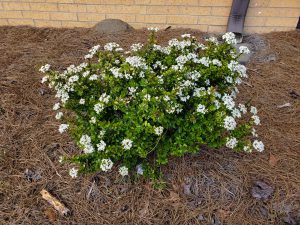
‘Whorled Class’ dwarf Walter’s Viburnum in a Calhoun County, FL landscape. Photo Credit: Daniel Leonard, University of Florida/IFAS Extension – Calhoun County.
Both the “wild-type” Walter’s Viburnum and the newer dwarf cultivars are about as low maintenance landscape shrubs as one could want. Though Walter’s normally occurs in shaded understory situations with moist, acidic soils in the wild, it is very adaptable to all manner of landscape situations. The species takes full sun extremely well but will also thrive with shade. It will tolerate very moist soil but, once established, is drought tolerant. I fertilize my Walter’s plants each spring with a general purpose, balanced garden fertilizer to boost growth, but there are many plantings of the species that get by without supplemental fertilizer. Finally, due to the dwarfing nature of the previously mentioned Walter’s cultivars, constant shearing won’t be necessary to maintain a pleasing shape, but they do respond well to pruning when a haircut is needed!
If you’ve been looking to include something a little bit different from the standard spring flowering fare in your landscape but also require your plants to be tough adaptable, try Walter’s Viburnum, especially the cultivars ‘Whorled Class’ or ‘Mrs. Schiller’s Delight’. They’ll be attractive, low-maintenance additions to nearly any Panhandle landscape for years to come! For more information about Walter’s Viburnum or any other horticultural or agricultural topic, contact your local UF/IFAS County Extension office. Happy gardening!
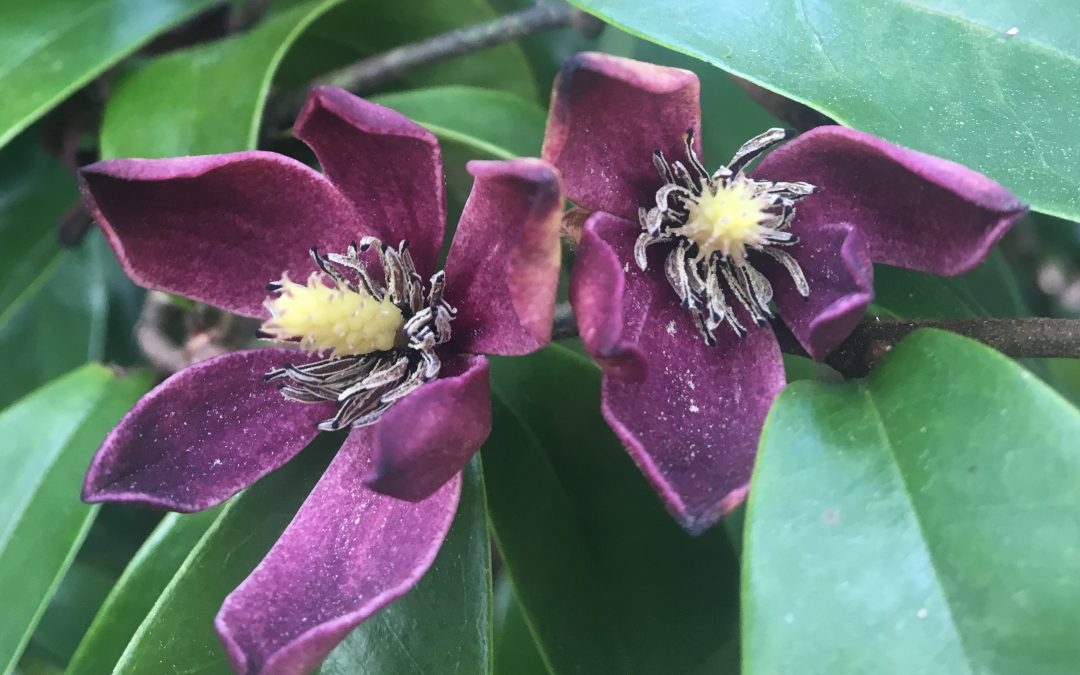
by Gary Knox | Sep 2, 2021
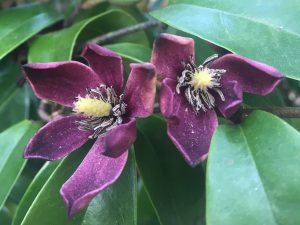
‘Stellar Ruby’ is a new purple-flowered hybrid banana-shrub that will soon be released nationally
You just learned about a fabulous new plant, and you HAVE to have it. How can you acquire this rare treasure?
Many of us gardeners have experienced this desire for a “new” plant but have quickly become frustrated with trying to locate and buy that particular plant. It’s not easy, or else that plant wouldn’t be new or rare, but the four P’s outline a few strategies for satisfying a “new” plant passion: plant societies, plant institutions, patience and payment.
Plant societies are one of the best avenues for acquiring new plants. Most plant societies consist of members with intense interest in particular plants or plant groups, so find the society that supports the plant that interests you. Plant society members often include breeders or plant explorers who introduce new plants. Whether magnolia or camellia or conifers or other plants, membership in such societies can give you a leg up on learning about, seeing, and accessing new plants. Consequently, fellow society members are often the first to acquire the newest plants, and that could be you!
Beyond this, participation in generalist plant groups can also give you unexpected benefits of networking with like-minded people. Thus, don’t overlook groups like Master Gardeners, garden clubs, or garden/park support groups. Their members often include passionate plant people like you who may have more connections (or special plants) than you realize.
Similarly, plant institutions such as universities or botanic gardens are another way to learn about and acquire new plants. These institutions often hold plant sales or fund-raising plant auctions that include new, unusual or rare plants. Online plant sales or auctions are becoming more common, so distance is less of an obstacle than it used to be. However, these institutions are less focused on particular plants, so it may be hit-or-miss to find that particular plant you want. To increase the chances of finding your desired plant, contact these institutions and ask to be notified about these events. You may even find a plant you didn’t know you wanted!
Patience is a virtue when trying to acquire new plants. Some plants take a long time to propagate or are not easy to propagate or grow. If you have the patience to wait, many plants will become more available – – – and at a more reasonable cost – – – as nursery production catches up to demand.
Finally, “payment”: let’s face it, money talks! If you have the funds, you can usually find the means to acquire the plants you desire. Most new or rare plants usually enter the market through specialty nurseries, operations that often maintain their own breeding or plant exploration programs or have exclusive arrangements with those who do. This is an expensive means of obtaining new plants, and therefore these specialty nurseries rightly charge more for their plants.
Another way money works to your advantage is the ability to travel. Many specialty nurseries, collectors, etc. often aren’t found in our part of Florida. If you can travel to these nurseries, botanic gardens, etc., it will be much easier to acquire unusual plants. If you can’t afford special trips to these sites, consider taking vacations to areas near these specialty nurseries, or to areas where these specialty nurseries are “on the way” to your vacation destination.
It goes without saying that you should learn about a “new” plant as much as possible before investing in an extensive hunt. Simple internet searches should tell you if that plant will be adapted to the climate and soil of your garden. At the other extreme, check resources like the IFAS Assessment (https://assessment.ifas.ufl.edu/) to make sure that particular plant won’t become invasive in your region of Florida.
Gardening is a very fulfilling activity, and the excitement of “new” plants just makes gardening more fun! Happy hunting!
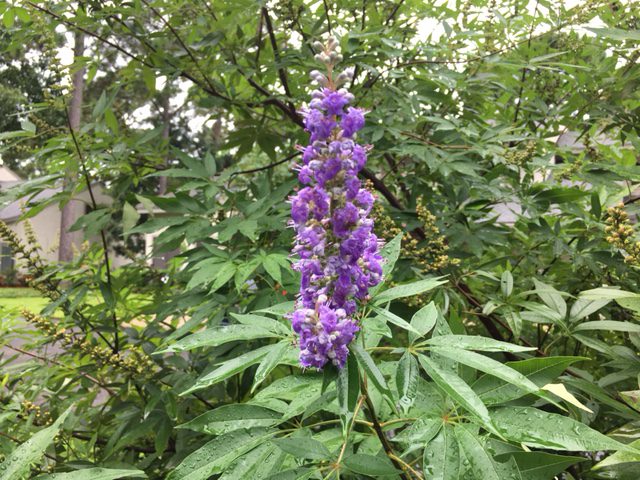
by Sheila Dunning | Aug 26, 2021
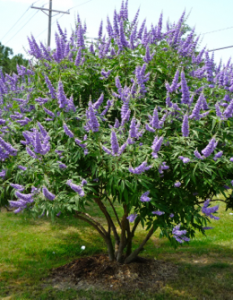
Photos by Sheila Dunning
The showy chaste tree makes an attractive specimen as the centerpiece of your landscape bed or in a large container on the deck. Much more of them are being seen since the Florida Department of Transportation has recognized the tree as a desirable median planting. Easy-to-grow, drought resistant, and attractive to butterflies and bees, Vitex agnus-castus is a multi-stemmed small tree with fragrant, upwardly-pointing lavender blooms and gray-green foliage. The chaste tree’s palmately divided leaves resemble those of the marijuana (Cannabis sativa) plant; its flowers can be mistaken for butterfly bush (Buddleia sp.); and the dry, darkened drupes can be used for seasoning, similar to black pepper, making it a conversation piece for those unfamiliar with the tree.
Vitex , with its sage-scented leaves that were once believed to have a sedative effect, has the common name “Chastetree” since Athenian women used the leaves in their beds to keep themselves chaste during the feasts of Ceres, a Roman festival held on April 12. In modern times, the tree is more often planted where beekeepers visit in order to promote excellent honey production or simply included in the landscape for the enjoyment of its showy, summer display of violet panicles.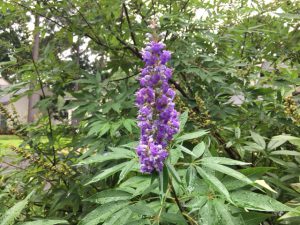
Chaste tree is native to woodlands and dry areas of southern Europe and western Asia. It will thrive in almost any soil that has good drainage, prefers full sun or light shade, and can even tolerate moderate salt air. Vitex is a sprawling plant that grows 10-20 feet high and wide, that looks best unpruned. If pruning is desired to control the size, it should be done in the winter, since it is a deciduous tree and the blooms form on new wood. The chaste tree can take care of itself, but can be pushed to faster growth with light applications of fertilizer in spring and early summer and by mulching around the plant. There are no pests of major concern associated with this species, but, root rot can cause decline in soils that are kept too moist.
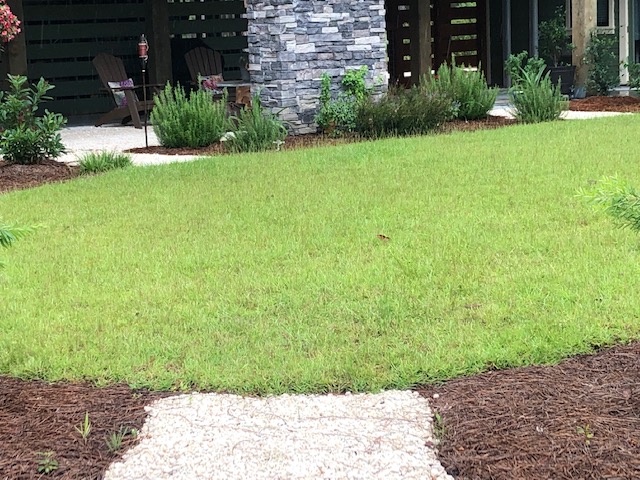
by Stephen Greer | Jul 1, 2021
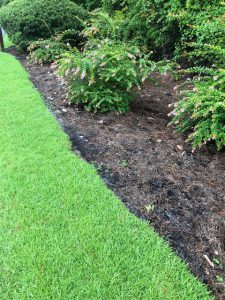
Photo Courtesy: Stephen Greer
Lawn areas come in all sizes and shapes. Some are large open expanses providing long views and others are smaller versions surrounded by shrubs and trees creating a more private and secluded setting. There are a number of reasons for reducing the size of a lawn with some coming into play with your decisions. A home lawn is often an important part of the landscape that provides a place to play outdoors from picnicking, tossing the ball to taking a quite stroll.
Maintaining a healthy lawn is important to an overall performance of this part of the landscape. Several factors are involved in the success in keeping a strong and resilient lawn. Understanding the needs of a grass to remain healthy involve soil testing to address soil pH and nutrient needs plus water challenges. Misuse of fertilizer and over irrigation can be costly to you and to the overall health of the lawn. These decisions can lead to reducing lawn size to managing cost or removing underused areas.
There are big benefits to reducing your lawn from saving time in mowing, trimming and other manicuring needs to saving energy costs involving the lawn mower not to mention reducing pollution from the mower or weed eater. The reduced amounts of pesticides needed to manage weeds and disease to the lawn saves time and money.
Another way to look at the reducing the size of our lawn is there will be more space for expanding plant beds and potential tree placement. These settings increase the opportunities for a more biodiverse landscape providing shelter, protection and food options for birds and other wildlife.
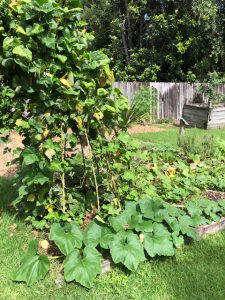
Photo Courtesy: Stephen Greer
The lawn can serve as a transition space that leads from one garden room space to another, while still offering a location to bring the lawn chair out to enjoy all that is around your lawn. Lawns and the landscape are ever changing spaces, especially as your trees and shrubs grow and mature to sizes that can directly impact the lawn performance. Often levels of shade will diminish edges and other areas of the lawn. This often will define the reduction of the lawn size moving going forward. Just remember that lawns and landscapes occupy a three-dimensional space involving the horizontal, vertical and overhead spaces. Just look around and think about what is best for you, your family and the setting.Are you more interested in developing other parts of the landscape? With many of us spending more time at home over the last year plus it gave time to think about the outdoor areas. Growing our own vegetables may be a new or expanding part of the landscape with the use of raised beds or interplanting into the existing landscape. Gardening can assist in reducing stress while at the same time providing that fresh tomato, lettuce, herbs and other fun healthy produce.
What ever your decisions are enjoy the lawn and landscape. For additional information, contact your local University of Florida IFAS Extension office located in your county.
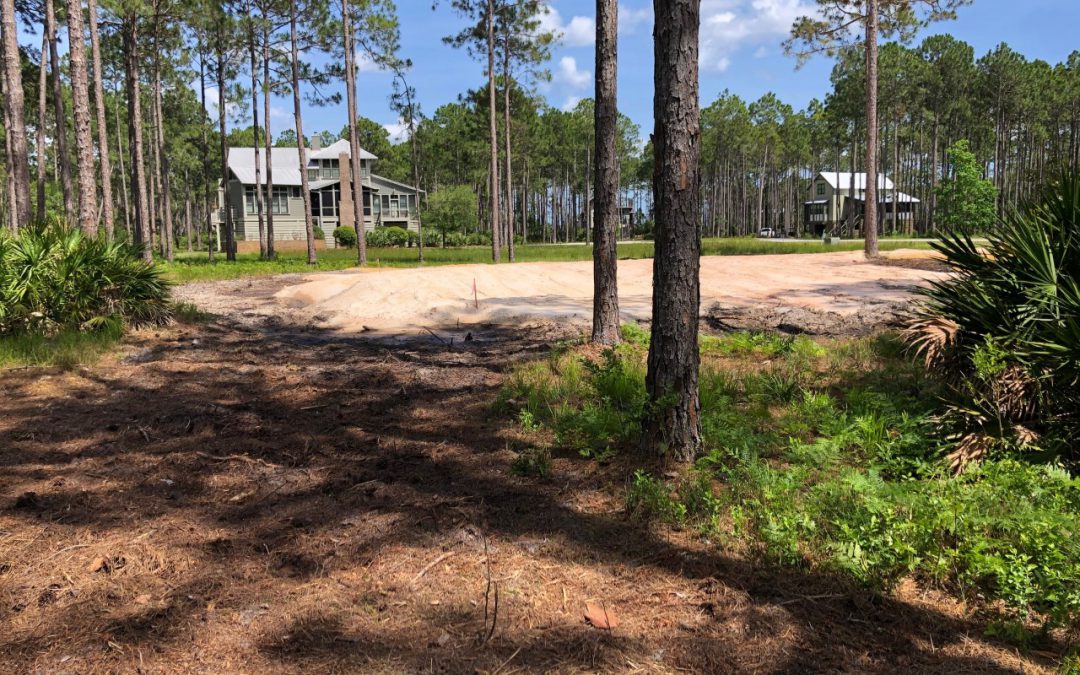
by Stephen Greer | May 27, 2021
As we have all observed communities are growing in the Panhandle through new home construction or through renovation of existing properties. This article will address new home construction. Many questions come to mind as construction begins with some of these questions needing to be addressed prior to start of construction. Determining impacts on the plant resources that already exist on the site should be included in the planning, design, construction and post-construction phases to be successful in achieving a healthy vibrant landscape for all to enjoy.
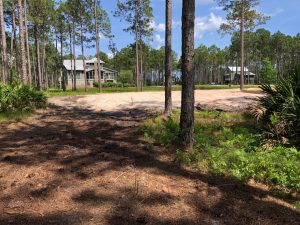
Photo Courtesy: Stephen Greer
Homes in community developments are being located on smaller lots in groups with conservation areas saved for the open spaces for all to enjoy. An older term for this was new urbanism and now is often referred to as conservation or clustered development. This type of development identifies and encourages environmentally friendly habitats for plants and animals creating a biodiversity within a walkable neighborhood designed to protect yet allow residence to enjoy some of the Northwest Florida beauty.
How can the objectives of building the new home desired, manage to protect the healthy plants already existing on the site? These challenges are difficult to answer but there are steps to accomplish both. For this article I will address construction and tree protection.
Protecting existing trees during the construction and post-construction phases takes expertise and a plan. First, consider hiring a professional arborist or urban forester to assist in this plan development. Understanding the existing trees on site prior to construction from the variety, location, visual impacts, size, overall health and location on the property are a good start. How do you protect the selected trees? First identify the trees that will need to be removed. Look for unhealthy stressed trees, significant limb death already occurring, poor crown growth (thinning) and other observations.
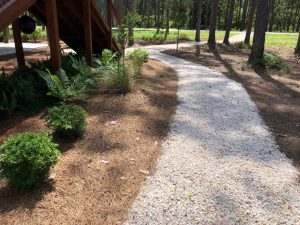
Photo Courtesy: Stephen Greer
The next step is to make a sight plan that needs to include grading needs for the home, drainage on the property, existing trees and surrounding vegetation, property lines, set back requirements, driveway location, utility placements and site of home. Flag trees that will be impacted and will need to be removed during the construction.
Following the sight plan, a tree protection plan needs to occur. This must happen before construction begins and include all parties involved to make sure all are in agreement. This is the stage where the group can identify conflicts involving tree protection and construction. Oversight by the owner, contractor and equipment operators is critical. A tree protection zone must be identified and implemented before construction. This typically involves setting up a fence around the protected trees and vegetation to restrict access of equipment and potential damage to the root system. A rule of thumb is to maintain a radius of at least 1.25 feet of protected area for each 1 inch of tree trunk diameter. An example would be a 12-inch diameter tree trunk with good protection at 15 feet to best protection at 30 feet of radius.
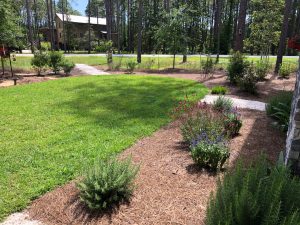
Photo Courtesy: Stephen Greer
The point is to give the best chance of a health survival of the tree during this soil and site disturbance as the construction process progress all the way to post construction with the removal of the protective fencing. Difficult decisions may need to be made of selecting trees to protect but will be needed. Enjoy the successes and plan for creating a new landscape that includes part of conserving plants that were there before and going forward.















